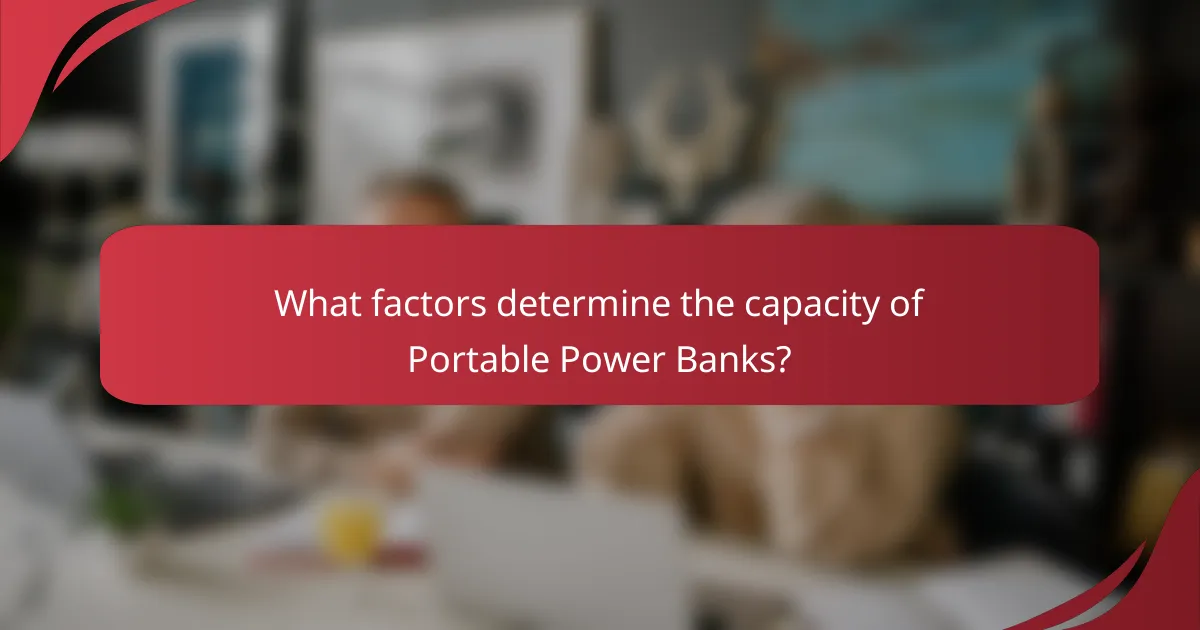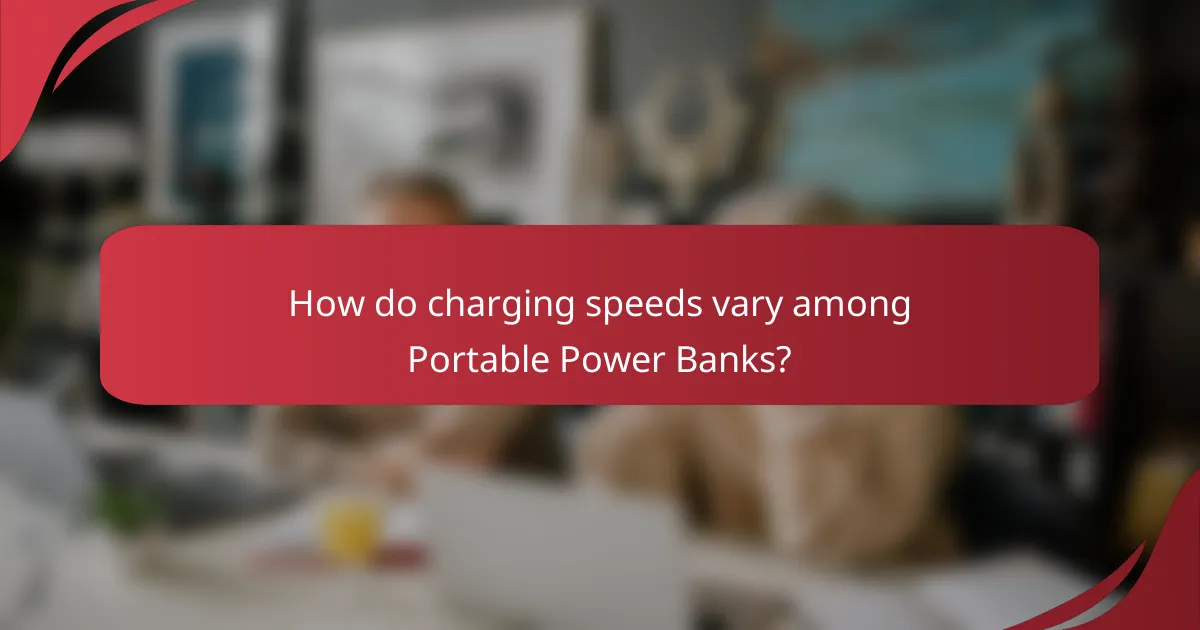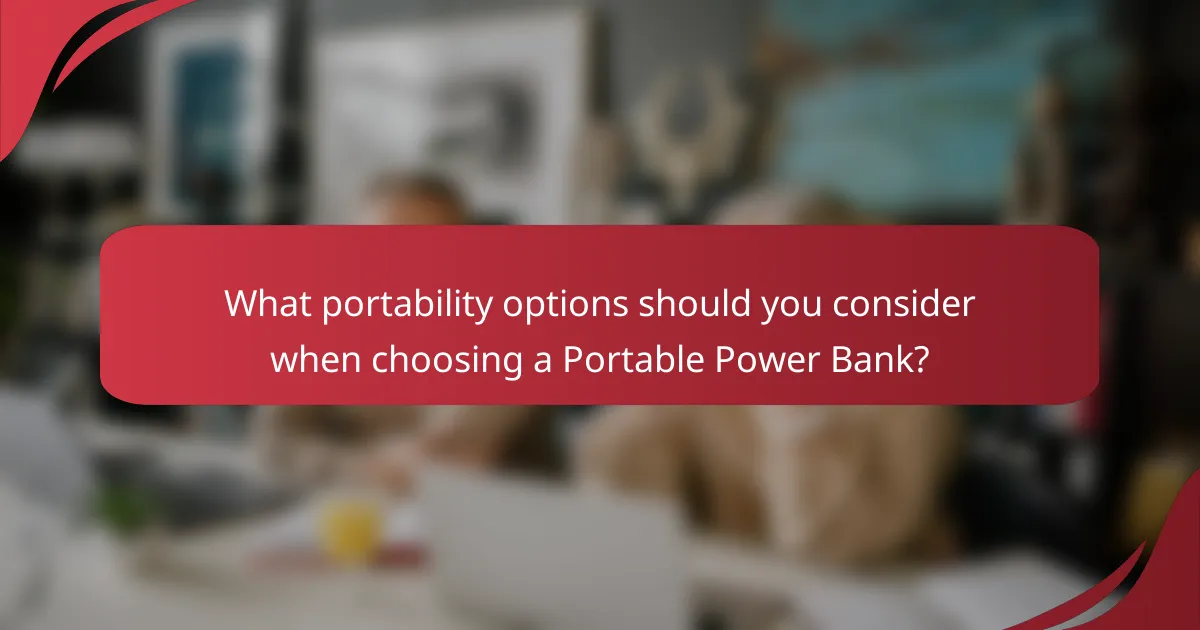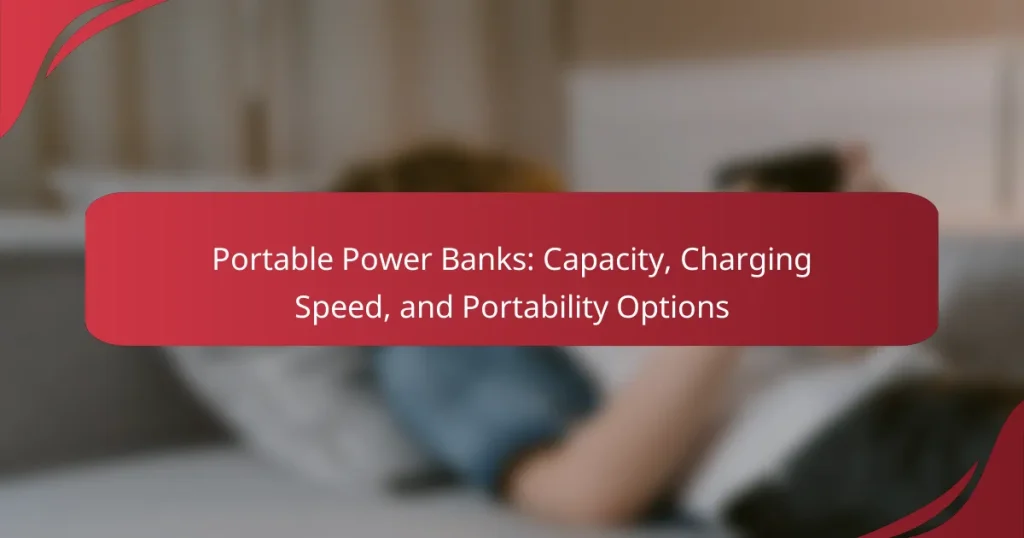Portable power banks are external battery packs that recharge electronic devices such as smartphones, tablets, and laptops while on the go. Their capacity, measured in milliampere-hours (mAh), determines how much energy they can store, with common ranges between 2,000 mAh and 30,000 mAh. Charging speeds vary based on output specifications, with higher wattage models offering faster charging capabilities, often enhanced by technologies like Quick Charge and Power Delivery. When selecting a power bank, factors such as size, weight, design, and the number of output ports play a crucial role in usability and convenience for different charging needs.

What are Portable Power Banks?
Portable power banks are external battery packs designed to recharge electronic devices on the go. They store electrical energy and provide it to devices like smartphones, tablets, and laptops. Most power banks connect via USB ports for charging. Their capacity is measured in milliampere-hours (mAh), indicating how much charge they can hold. Common capacities range from 2,000 mAh to 30,000 mAh. Charging speed varies based on the power bank’s output specifications. Many models support fast charging technologies. Portable power banks enhance convenience by ensuring devices remain powered during travel or emergencies.
How do Portable Power Banks function?
Portable power banks function by storing electrical energy in rechargeable batteries. They convert this stored energy into a usable form to charge electronic devices. When a device is connected, the power bank releases electricity through its output ports. Most power banks use lithium-ion or lithium-polymer batteries for efficient energy storage. They typically feature a USB output for compatibility with various devices. The power bank’s capacity is measured in milliamp hours (mAh), indicating how much energy it can store. For example, a 10,000 mAh power bank can charge a smartphone multiple times. Additionally, many power banks include features like fast charging and multiple output ports for convenience.
What components make up a Portable Power Bank?
A Portable Power Bank is made up of several key components. The main component is the battery, typically lithium-ion or lithium-polymer. This battery stores electrical energy for later use. Another important component is the circuit board, which manages power distribution and charging functions. Additionally, there are input and output ports, usually USB, for connecting devices. Some power banks include a built-in LED indicator to show battery levels. A protective casing encases all components, providing durability and portability. Each component works together to ensure effective charging and energy storage.
How do these components influence charging efficiency?
Charging efficiency in portable power banks is influenced by components such as battery capacity, output voltage, and charging circuitry. Higher battery capacity allows for more energy storage, which can improve efficiency during charging cycles. Output voltage affects how quickly energy is transferred to the device being charged. Efficient charging circuitry minimizes energy loss during the conversion process. For instance, advanced circuitry can reduce heat generation, which is a common inefficiency in charging. Additionally, the compatibility of the power bank’s components with the device’s charging requirements can significantly impact overall efficiency. Studies show that power banks with optimized circuitry can achieve up to 90% efficiency in energy transfer.
What are the key benefits of using Portable Power Banks?
Portable power banks provide essential backup power for devices. They allow users to charge smartphones, tablets, and other electronics on the go. This convenience is especially valuable during travel or outdoor activities. Many power banks are compact and lightweight, making them easy to carry. They often feature multiple charging ports for simultaneous device charging. Some models offer fast charging capabilities, reducing downtime. Additionally, they come in various capacities to meet different power needs. According to a survey by Statista, 67% of smartphone users find portable chargers essential for daily use.
How do Portable Power Banks enhance mobile device usability?
Portable power banks enhance mobile device usability by providing additional battery life on-the-go. They allow users to charge devices without needing a wall outlet. This convenience is crucial during travel or outdoor activities. Power banks typically have various capacities, enabling multiple charges for different devices. For instance, a 10,000 mAh power bank can charge a smartphone two to three times. Most power banks are compact and lightweight, making them easy to carry. Additionally, many models offer fast charging capabilities, reducing downtime for users. Overall, they significantly improve the accessibility and functionality of mobile devices in diverse situations.
Why are Portable Power Banks essential for travelers?
Portable power banks are essential for travelers because they provide a reliable source of energy for electronic devices. Travelers often rely on smartphones, tablets, and GPS devices for navigation and communication. These devices can run out of battery quickly, especially during long journeys. A portable power bank ensures that travelers can recharge their devices on the go. According to a survey by Statista, 75% of travelers reported that staying connected is crucial during their trips. This highlights the importance of having a backup power source. Additionally, portable power banks are compact and lightweight, making them easy to carry. They can charge multiple devices simultaneously, enhancing their utility for group travel.

What factors determine the capacity of Portable Power Banks?
The capacity of portable power banks is primarily determined by their battery size, measured in milliampere-hours (mAh). Larger mAh ratings indicate more stored energy, allowing for multiple device charges. The battery chemistry also influences capacity; lithium-ion batteries are common due to their high energy density. Additionally, the efficiency of the power bank’s circuitry affects how much energy is usable. Design factors, such as the number of output ports, can also play a role in distributing capacity across devices. Finally, the intended use case, such as charging smartphones versus laptops, can dictate the required capacity.
How is capacity measured in Portable Power Banks?
Capacity in portable power banks is measured in milliampere-hours (mAh). This unit indicates how much electric charge the power bank can store. A higher mAh rating means the power bank can supply power for a longer duration. For example, a power bank rated at 10,000 mAh can theoretically charge a smartphone with a 2,500 mAh battery four times. Capacity also reflects the energy available for charging devices. Manufacturers often display this value on the power bank’s packaging. It’s essential to consider efficiency losses during charging, which can affect actual performance.
What is the significance of mAh in Portable Power Banks?
mAh, or milliampere-hour, is a measurement of electrical capacity in portable power banks. It indicates how much charge a power bank can store and deliver to devices. A higher mAh rating means the power bank can supply more energy before needing a recharge. For example, a 10,000 mAh power bank can typically charge a smartphone two to three times, depending on the phone’s battery capacity. This measurement is crucial for users selecting a power bank that meets their charging needs. Understanding mAh helps consumers choose a power bank that aligns with their usage patterns and device requirements.
How does capacity impact charging multiple devices?
Capacity directly influences the ability to charge multiple devices simultaneously. A power bank with higher capacity can store more energy, allowing it to charge several devices before depleting. For example, a 20,000 mAh power bank can typically charge a smartphone multiple times, depending on the phone’s battery size. Conversely, a lower capacity power bank, such as one with 5,000 mAh, may only provide a single charge for a smartphone. The charging speed also varies with capacity; larger capacity power banks often support faster charging technologies. Overall, the capacity of a power bank determines how many devices can be charged and how quickly they can be charged before the power bank needs recharging itself.
What are the different capacity options available?
Portable power banks are available in various capacity options. Common capacities include 5,000 mAh, 10,000 mAh, 20,000 mAh, and 30,000 mAh. These capacities determine how many times a power bank can charge a device. For instance, a 10,000 mAh power bank can typically charge a smartphone two to three times. Higher capacities, like 20,000 mAh, are suitable for multiple devices or extended trips. Manufacturers provide these options to cater to different user needs and device requirements.
What are low-capacity Portable Power Banks suitable for?
Low-capacity portable power banks are suitable for charging small devices. These devices include smartphones, fitness trackers, and Bluetooth headphones. Typically, low-capacity power banks have a capacity ranging from 1,000 to 5,000 mAh. This capacity is ideal for providing one or two full charges for most smartphones. They are lightweight and compact, making them easy to carry. Users often choose them for short trips or daily commutes. Their low weight adds minimal bulk to bags or pockets. Additionally, they can be used as emergency chargers when needed.
How do high-capacity Portable Power Banks compare?
High-capacity portable power banks generally offer greater battery capacity than standard models. Their capacity is typically measured in milliampere-hours (mAh). Many high-capacity options range from 20,000 mAh to 50,000 mAh. This allows them to charge multiple devices multiple times.
Charging speed can vary among high-capacity power banks. Some support fast charging technologies like Quick Charge or Power Delivery. This can significantly reduce the time needed to recharge devices.
Portability is another factor to consider. High-capacity power banks tend to be larger and heavier than lower-capacity models. This may affect their ease of transport.
In summary, high-capacity portable power banks provide more power and faster charging but may sacrifice portability due to their size.

How do charging speeds vary among Portable Power Banks?
Charging speeds among Portable Power Banks vary based on their output specifications. Most power banks offer different charging speeds measured in watts (W). Common output ratings include 5W, 10W, 18W, and 30W. Higher wattage allows for faster charging of devices. For example, a 30W power bank can charge a smartphone significantly quicker than a 5W model. Additionally, technologies like Quick Charge and Power Delivery enhance charging speeds. These technologies adjust voltage and current for optimal charging. As a result, the same device can charge faster with a compatible power bank that supports these features.
What factors influence the charging speed of Portable Power Banks?
The charging speed of portable power banks is influenced by several key factors. First, the output power rating, measured in watts (W), determines how quickly a device can charge. A higher wattage output allows for faster charging. Second, the capacity of the power bank, measured in milliampere-hours (mAh), affects how much energy it can store and deliver. Third, the charging technology used, such as Quick Charge or Power Delivery, enhances charging speeds. Fourth, the quality of the cables and connectors plays a critical role; low-quality cables can limit charging efficiency. Lastly, the device being charged also impacts speed; different devices have varying charging requirements.
How do output power ratings affect charging speed?
Output power ratings directly determine charging speed. Higher output power ratings allow devices to draw more current, resulting in faster charging. For example, a power bank with a 20W output can charge a smartphone significantly quicker than one with a 5W output. This is because the device can utilize the higher wattage to increase the flow of electricity. Most modern smartphones support fast charging, requiring higher output ratings to achieve optimal speeds. Studies show that charging a device at 18W can reduce charging time by up to 50% compared to lower wattage options. Thus, output power ratings are critical for maximizing charging efficiency and speed.
What role does cable quality play in charging speed?
Cable quality significantly influences charging speed. High-quality cables have better conductivity. This reduces resistance and allows more current to flow. Poor-quality cables can restrict current flow. This leads to slower charging times. For example, a cable rated for 2.4A can charge devices faster than one rated for 1A. Additionally, the materials used in construction impact durability and efficiency. Premium cables often use thicker wires and better insulation. This ensures minimal energy loss during charging. Overall, investing in quality cables enhances charging performance.
What are the common charging technologies used in Portable Power Banks?
Common charging technologies used in portable power banks include USB-C Power Delivery, Quick Charge, and standard USB charging. USB-C Power Delivery allows for fast charging by delivering up to 100 watts of power. Quick Charge technology, developed by Qualcomm, enables compatible devices to charge significantly faster than standard USB. Standard USB charging is the most basic form, typically providing 5V at 1A or 2A. These technologies enhance charging efficiency and speed, catering to various devices and user needs.
How does Quick Charge technology work in Portable Power Banks?
Quick Charge technology enables faster charging in portable power banks by increasing the voltage and current delivered to devices. It utilizes a communication protocol between the power bank and the device to determine the optimal charging parameters. This technology can adjust the voltage levels dynamically, typically ranging from 5V to 12V or higher. By doing so, it reduces charging time significantly compared to standard charging methods. For instance, Quick Charge 3.0 can charge compatible devices up to 80% in 35 minutes. This efficiency is achieved through advanced power management and thermal regulation features built into the power bank.
What is Power Delivery, and how does it benefit users?
Power Delivery (PD) is a fast-charging technology that allows for higher power levels to be transferred between devices. It enables devices to charge quickly and efficiently by negotiating the optimal power level needed. This results in reduced charging time compared to traditional charging methods. For example, Power Delivery can deliver up to 100 watts, which is sufficient for charging laptops and other high-power devices. Users benefit from this technology as it enhances convenience and reduces downtime. Faster charging times mean less waiting and more productivity. Additionally, PD is versatile, supporting various devices with different power needs, thus simplifying the charging process.

What portability options should you consider when choosing a Portable Power Bank?
When choosing a portable power bank, consider its size, weight, and design. A compact size enhances ease of transport, fitting into bags or pockets. Lightweight power banks reduce the load during travel. The design should include features like a built-in strap or case for convenience. Additionally, look for options with multiple charging ports for versatility. These features enhance usability in various situations.
How do size and weight affect the portability of Power Banks?
Size and weight significantly impact the portability of power banks. Smaller and lighter power banks are easier to carry and fit into pockets or bags. They enhance user convenience for on-the-go charging. Conversely, larger and heavier power banks may offer higher capacity but can be cumbersome to transport. For instance, a power bank weighing over 500 grams becomes less appealing for daily carry. Overall, the trade-off between capacity and portability is crucial for user satisfaction.
What are the most compact Portable Power Banks on the market?
The most compact portable power banks on the market include the Anker PowerCore Slim 10000, the RAVPower 10000mAh Power Bank, and the Aukey 10000mAh Power Bank. The Anker PowerCore Slim 10000 measures 5.4 x 2.9 x 0.6 inches and weighs 6.3 ounces. It has a capacity of 10,000mAh, providing multiple charges for smartphones. The RAVPower 10000mAh Power Bank is similarly sized at 5.5 x 2.9 x 0.5 inches and weighs 7.1 ounces. It features fast charging technology and a 10,000mAh capacity. The Aukey 10000mAh Power Bank is compact at 5.4 x 2.9 x 0.5 inches and weighs 6.7 ounces. It also offers a 10,000mAh capacity and built-in safeguards for device protection. These power banks are recognized for their portability and efficiency.
How does battery design influence portability?
Battery design significantly influences portability by determining size, weight, and form factor. Compact designs allow for lighter and smaller power banks. Lighter batteries enhance ease of transport and usability. Form factor affects how easily a battery can fit into bags or pockets. Advanced materials, like lithium polymer, reduce weight while maintaining capacity. Battery design also influences the overall aesthetic, which can impact user preference for portability. For example, slimmer designs are often more desirable for on-the-go use. Efficient internal layouts can maximize energy density, allowing for more power in a smaller package.
What additional features enhance the portability of Power Banks?
Lightweight design enhances the portability of power banks. Many models weigh less than 200 grams, making them easy to carry. Compact size also contributes to portability. Power banks that fit in pockets or small bags are more user-friendly. Built-in cables eliminate the need for extra accessories. This feature reduces bulk and simplifies transport. Multi-device charging capability increases functionality without adding weight. Some power banks have integrated clips or straps for easy attachment to bags. These features collectively improve the overall convenience of carrying power banks.
How do built-in cables improve convenience?
Built-in cables improve convenience by eliminating the need to carry separate charging cords. Users can access power instantly without searching for additional accessories. This feature reduces clutter and enhances portability. Many portable power banks now include integrated cables for various devices. This adaptability allows users to charge multiple devices without extra items. Built-in cables also minimize wear and tear on external connectors. As a result, they provide a streamlined and efficient charging solution. Overall, built-in cables enhance user experience by simplifying the charging process.
What accessories can enhance the portability of Power Banks?
Accessories that can enhance the portability of power banks include carrying cases, keychain attachments, and travel pouches. Carrying cases protect the power bank from damage and make it easier to transport. Keychain attachments allow users to clip the power bank to bags or belts for quick access. Travel pouches provide additional storage for cables and adapters, keeping everything organized. These accessories improve mobility and convenience for users on the go.
What are the best practices for using Portable Power Banks effectively?
To use portable power banks effectively, ensure they are fully charged before use. Check the power bank’s capacity, measured in milliamp hours (mAh), to match your device’s needs. Use the appropriate charging cable for optimal charging speed. Avoid exposing the power bank to extreme temperatures, as this can damage the battery. Regularly test the power bank to ensure it holds a charge. Store the power bank in a dry place to prevent moisture damage. Disconnect devices once fully charged to prolong battery life. Follow manufacturer guidelines for charging cycles to maintain performance.
Portable power banks are external battery packs designed to recharge electronic devices, enhancing convenience during travel or emergencies. This article covers essential aspects such as the capacity of power banks, which is measured in milliampere-hours (mAh), and how it influences charging multiple devices. Additionally, it discusses various charging speeds, factors affecting efficiency, and the importance of portability features. Readers will gain insights into the components that make up power banks and the technologies that enhance their performance, ensuring users can select the right power bank for their needs.


